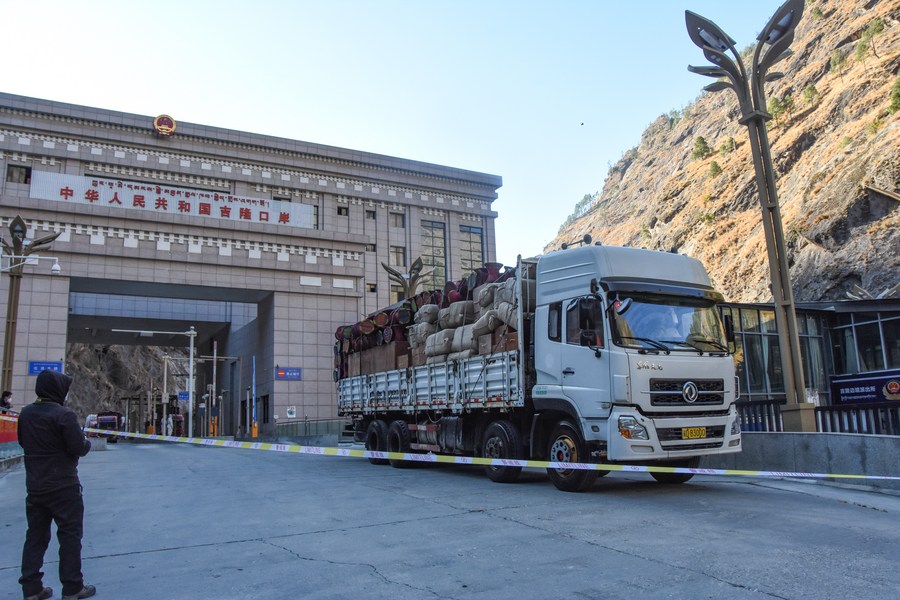I recently embarked on a journey to Gyirong, a charming border town nestled between China and Nepal. It is about 820 km west of Lhasa, the regional capital of Tibet, and lies about 131 km from the Nepalese capital Kathmandu.
Upon arriving in the evening, I checked into a modest yet cozy hotel. To my amusement, a dzo (a hybrid of a bull and a yak) was casually strolling outside the lobby, crossing the street while paying no heed to the traffic light at the intersection. It must have been used to meandering in the area for quite some time.
After dinner, I decided to explore the quaint town on foot. With merely two main thoroughfares in the town, a half-hour amble suffices to explore its charm.
Renowned for its delectable Nepalese cuisine, Gyirong had been highly recommended to me by several friends, who specifically extolled the delightful pairing of curry and rice as a must-try.
Much to my surprise, I discovered that a multitude of local stores brimmed with an array of products ready for export. One store owner, with an air of intrigue, confided in me, whispering his conviction that a wave of Nepalese customers would soon descend upon his shop to replenish their stocks. His confidence was palpable and contagious.
I was really happy for him. The past few years have not been easy for merchants in the town. In 2015, mega earthquakes struck Nepal and affected Gyirong. Houses tumbled down, roads were destroyed, and people relocated. Post-quake reconstruction was initiated soon after. However, just as a brand-new town was about to embrace its former prosperity, the COVID-19 pandemic hit.
Yet now, everyone who came to Gyirong could sense that something is different.
As I breathed in the air, I could sense the arrival of spring with its distinct warmth and humidity, typical of the southern foothills of the Himalayas.
The Himalayas have cut open five north-south rift valleys in Xigaze under Tibet. The valley where Gyirong is located is the westernmost and longest of them all, stretching approximately 93 km.
Distinctly contrasting my perception of the world’s rooftop as a frigid and arid snow-laden plateau, Gyirong Town nestles within a deep valley, sitting at an elevation of approximately 2,800 meters above sea level, invigorating and pleasant.
The aura of the atmosphere instantly reminded me of a Chinese adage that goes: “The Gyirong valley has witnessed half the history of Tibet.”
Throughout history, the border town has been a vital area in the valley. International tourists often enter China through Nepal, and vice versa. Merchants from Nepal and other South Asian countries operate businesses in the area, while workers from the other side of the border come to China to seek employment.
The valley has served as a crucial transportation route between the hinterland of the Qinghai-Tibet Plateau and South Asia. Historically, it has functioned as a combination of an “official road” and a “commercial road.”
Cliff inscriptions in Chinese language documenting a Tang Dynasty diplomat’s mission to ancient India dating back to 658 A.D. were found here, which confirm that the Gyirong valley was an official road connecting Tang, the Tubo regime established in Tibet in the seventh century, and South Asia.
Scientists conducted DNA analysis on carbonized rice discovered in this region and dated it to the eighth century. However, the researchers noted that Gyirong did not have the necessary thermal conditions for indica rice cultivation. Therefore, the unearthed rice must have been transported to higher altitude areas for consumption through trade or other means.
In addition to its long history, the small town has undergone significant changes in the new era.
Today, a land port has been built on the ancient commercial site. During my visit there, I saw a bridge straddling the boundary river, the third one linking the two countries. From a shabby wooden bridge to a narrow iron cable bridge, to today’s concrete two-lane bridge, they are all witnesses to the development of bilateral exchange and trade between China and Nepal.
In 1961, Gyirong port attained approval for opening. It was declared a second-class land port in 1972 and was upgraded to a national first-class land port in 1987.
Thanks to the Belt and Road Initiative, the volume of border trade at the Gyirong port has steadily grown. In 2017, the port was designated as an international port, thereby allowing access to individuals from third countries besides China and Nepal.
Just in March 2022, a border economic cooperation zone was approved to be established here, making Gyirong the 18th of its kind in China and the first in Tibet.
According to the government plan, by 2035, Gyirong will be built into an important passageway linking the inland region with South Asia, a new model of Tibet’s opening-up cooperation, and a border ecological city suitable for living, working and traveling.
The movement of people and goods came to a halt due to the COVID-19 restrictions. However, as of December 2022, two-way cargo transport has been restored. According to a customs officer, personnel exchange will also soon resume.
“I am very much looking forward to the resumption of personnel exchange, and plan to return to Nepal to visit my family in April,” Tsering, a Nepalese businessman based in Gyirong, told me.










